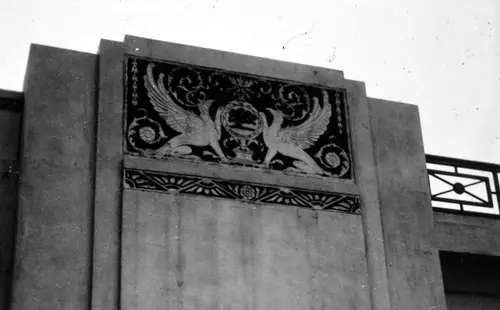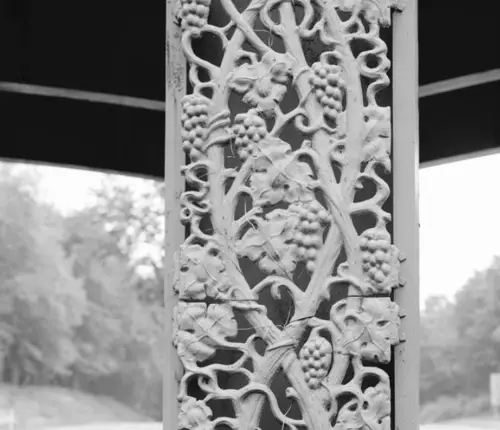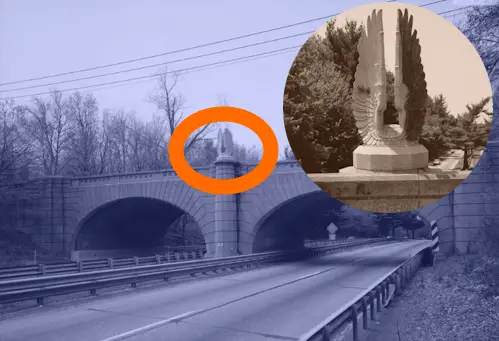In July 1934, a Connecticut congressman named Schuyler Merritt presided over the groundbreaking ceremony for the Merritt Parkway. The road would be “constructed for pleasant transit,” he said.
Tell that to the motorists who navigate the tight curves, narrow lanes, short ramps, dangerous entrances and low bridges that pinch cars together at an average speed of 73 mph—at least during non-rush hours.
Designed for Chrysler Airflows, Buick Roadsters and Cadillac All-Weather Phaetons, the Merritt Parkway originally had speed limits averaging 40-mph. The road stretched from the New York state line to the Housatonic River in Stratford. As a pleasant and quick way to travel from New York to the countryside, it spurred the development of Fairfield County’s tony suburbs.

“Driving into Connecticut on the Merritt Parkway gives drivers a fleeting glimpse of Fairfield County 60 years ago, when back-country Greenwich was still a hodgepodge of cow pastures and 20-acre estates,” reported the New York Times on Jan. 30, 2020. The story appeared after an accident on Dead Man’s Curve killed two Greenwich high school students.
“It is also a highway that thousands of commuters use to get to their jobs in New York, and although it is a beautiful road, the nearly eight-mile stretch of highway here can be dangerous,” reported the newspaper.
In the Merritt’s most recent history, preservationists and transportation officials have tried to balance scenic beauty and historic integrity with highway safety and efficiency. After all, those flowering trees are nice until someone dies crashing into them.
The Connecticut Department of Transportation can only do so much. The Merritt Parkway is listed on the National Register of Historic Places. The 37.5-mile road is Connecticut’s largest—and most heavily visited—National Register historic district.

Steel flowers on a bridge in Stratford are one reason the Merritt is on the National Register
Merritt Parkway
It’s hard to believe today, but aesthetic ideals once inspired highway construction.
The Merritt resulted in part from the City Beautiful movement during the first half of the 20th century. City Beautiful advocates believed parkways linking parks outside of cities would alleviate urban problems like crime and delinquency.
The Merritt was actually the last of the New York area parkways. Urban planner Robert Moses had created a system of parks and parkways in New York City as well as Long Island. And right across the Connecticut border, Westchester County in 1906 began building parkways – the Saw Mill River, the Hutchinson River, the Briarcliff-Peekskill, and Cross County Parkways. In Washington, D.C., the George Washington Memorial Parkway opened in 1932. (Note: the urban problems didn’t go away.)

An abutment with sculpture on the Grumman Avenue Bridge in Norwalk
By then, the National Park Service had come up with a formal definition of a parkway. A parkway had to
- Only allow recreational, noncommercial traffic;
- Prohibit unsightly roadside development and signs;
- Include wide rights-of-way to buffer abutting property;
- Encourage preservation of natural scenery by granting no frontage or access rights;
- Prefer a new site to avoid congested and built-up areas;
- Give best access to native scenery
- Eliminate major grade crossings; and
- Reduce traffic congestion with well-distanced entrances and exits. (On the Merritt, No Man’s Land runs 5.5 miles between exit 42 in Westportand exit 44 in Fairfield.
The Merritt qualified.
The Quintessential Parkway
The Merritt was one of the last of the parkways. It “culminated a generation of experiments in combining the talents of engineers, landscape architects and architects to create parkways that served recreational purposes and gave aesthetic pleasure while providing safe transportation,” according to the nomination for the National Register. “In it, all the best features developed in its predecessors were put together to create the quintessential parkway.”
But World War II came along, and the German autobahn became the model for high speed travel over highways.
Renovating the Merritt Parkway
In the late 1970’s and early 1980’s, two new interchanges went up over the Merritt Parkway in Trumbull. They endangered the road’s historic nature and agitated preservationists, who then in 1991 managed to get the parkway listed on the National Register.

The Redding Road Bridge on the Merritt Parkway
In 1992, the state Department of Transportation created a working group to come up with guidelines for maintaining and rehabilitating the parkway. Around 2000, the Merritt Parkway Conservancy began as a specialized SWAT team to make sure CTDOT complied with those guidelines. The Conservancy, for example, inspects every tree before it is cut down or moved.
CTDOT has since worked to rehabilitate all 37.5 miles of the parkway. It has repaved the roadway, removed invasive species and installed wood guardrails reinforced with steel. It has cut down trees and removed ledge, recolored concrete bridges for historical accuracy and rehabilitated the Colonial Revival service stations. The state also began to allow fast-food vendors in the rest areas for the first time.
Here are some more fun facts about the Merritt Parkway.
1.It was originally called the Parallel Post Road.
The Merritt didn’t start off as a parkway, but as a solution to traffic congestion. The old Boston Post Road, the only shoreline artery linking New Haven with New York City, had gotten crowded and dangerous. In 1925, Gov. John H. Trumbull said he’d support a plan to build an alternate road.
Schuyler Merritt, the Republican congressman from Fairfield County, headed a commission to get the parkway built. For that, county Republicans urged the state to name the parkway after him.
2. A corrupt political hack bought the land for the parkway. He went to prison.
Leroy Kemp belonged to the Fairfield County Republican machine, and when it came time to buy rights-of-way for the Merritt, he got the job. Kemp, a Darien real estate broker, had served as a state representative and had a lot of friends in the state GOP.
Kemp ultimately inflated the cost of land purchases to $6.5 million, a whopping amount of money back then.
He took advantage of the secretive highway commissioner, John MacDonald, who refused to disclose plans for the parkway.

A Colonial Revival service station in Fairfield
Since no one knew where the road would go, Kemp told his real estate broker friends what parcels the highway department needed. They would then approach the landowners and offer to negotiate with the state. When the seller agreed to sell for a price, two, five and ten times the market value, the real estate agents would then split their fees with Kemp. In one deal, for example, Kemp had the state buy a piece of land in Greenwich for $93,000. Fair market value was $7,458.
Eventually people got suspicious. The state and the press investigated, and ultimately Kemp was sentenced to three to seven years in the penitentiary. A jury found him guilty of conspiracy after three hours of deliberation.
A grand jury found Connecticut Highway Commissioner “entirely to blame” for most of the “waste, extravagance and incompetence” in buying the parkway’s rights of way. MacDonald resigned in disgrace after 15 years on the job.

Ornamental detail on the Lake Avenue Bridge
3. Nude swimmers and picnickers caused problems in the early years.
When the Merritt Parkway opened, people started taking picnic lunches and relaxing by the side of the road.
Harold Ross, editor of the New Yorker, complained to CTDOT about skinny dippers in a creek that passed under the Merritt and over his property.
4. Tollbooths caused a stir. Now they’re museum pieces.
Many people objected to the state’s announcement that it would collect 10-cent tolls in Greenwich and Milford (near the parkway’s entrance). People felt the government taxed them twice since taxes, not tolls, paid for the parkway’s construction.

Merritt Parkway toll booth at the Boothe Memorial Park
The highway architect, George Dunkelberger designed rustic, whimsical Log Cabin-style tollbooths. An out-of-work electrical engineer named Theodore Fleischmann paid the first toll at the Greenwich toll booth without complaint. But others protested by paying in pennies or throwing trash near the toll booths. One man drove fast through the tollbooth, then threw his dime in the grass.
When Connecticut eliminated tolls in 1988, the Milford toll booth went to Boothe Memorial Park in Stratford. Part of the Greenwich toll plaza went to the Henry Ford Museum in Dearborn, Mich.
5. The original 69 mostly-much-admired bridges are all different.
An urban legend about the bridges says different people made proposals to the highway department. Since government officials couldn’t make up their minds, they selected them all. But it’s wrong. A single architect, George Dunkelberger, came up with the idea of building attractive, unique bridges.

The James Farm Road overpass with Nike wings
He designed most of them in the then-popular Art Deco or Art Moderne style. Some of the notable work includes relief sculptures of a Puritan and an Indian on the Comstock Hill overpass in Norwalk. Dunkelberger elaborately ornamented the Lake Avenue Bridge. He put concrete Nike (the goddess not the shoe) wings on the James Farm Road overpass.
For some bridges, Dunkelberger took inspiration from fortified French bridges of the Gothic and Renaissance eras. On the Route 110 bridge in Stratford he applied metal flowers.

The Comstock Hill overpass in Norwalk
Works Progress Administration workers built some of the bridges.
One exception is at exit 39, which has ordinary modern bridges constructed using undecorated concrete-on-steel I-beams. The highway department got a grant to build the bridge, but it didn’t cover the cost of decoration.

The Comstock Hill overpass in Norwalk.
6. It took 200 gardeners to landscape the Merritt Parkway.
A roadside development team of 200 men planted and shaped the parkway’s s surroundings. They removed mature trees from the path of the road and stored them for later replanting, and they scraped topsoil to use along the roadside. Earl Wood, engineer of roadside development, later recalled, “The general objective was to help nature heal the scars of construction.”

Weld Thayer Chase, a 27-year-old landscape architect, supervised the landscaping. Wanting a splendid spring bloom, he contracted for 47,700 laurels and 3,777 dogwoods, He also bought 6,459 pines, 3,095 cedars and 2,037 hemlocks. In addition, Fairfield County garden clubs helped with the landscaping, donating thousands more flowering trees and shrubs. The parkway once had 17 bronze plaques embedded in rocks to commemorate the garden clubs’ efforts.
Chase also planted Oriental bittersweet, which has since overgrown the parkway. (Well, he was only 27.)

7. Commercial vehicles are still not allowed on the Merritt Parkway.
Technically, the Merritt Parkway doesn’t allow trucks, RV’s, cars towing trailers, buses and all commercial vehicles. However, commercial vehicles do flout the law, and trucks have gotten stuck under the 11-foot-high bridges.
The state police say they have higher priorities than keeping pick-up trucks off the Merritt.

The Nichols-Shelton Road Bridge
All black and white photos courtesy Library of Congress.

